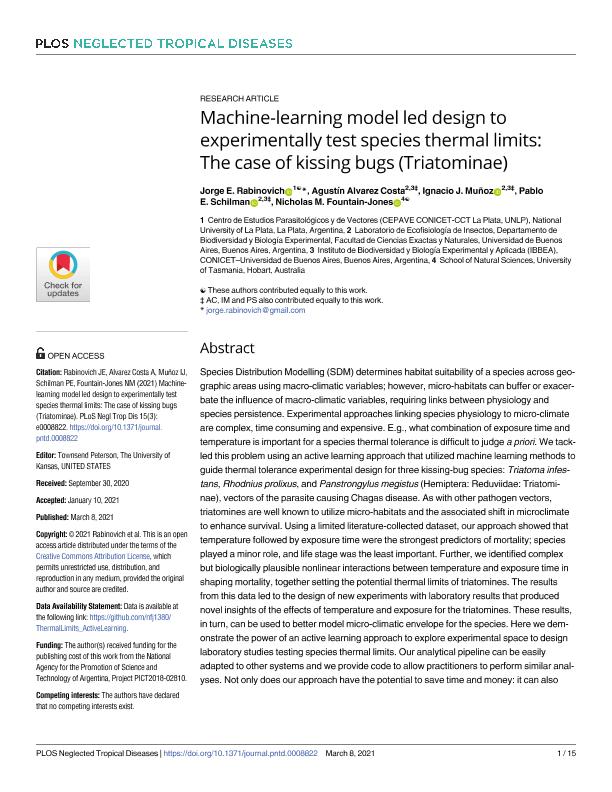Artículo
Machine-learning model led design to experimentally test species thermal limits: The case of kissing bugs (triatominae)
Rabinovich, Jorge Eduardo ; Alvarez Costa, Agustin
; Alvarez Costa, Agustin ; Muñoz, Ignacio Joaquín
; Muñoz, Ignacio Joaquín ; Schilman, Pablo Ernesto
; Schilman, Pablo Ernesto ; Fountain Jones, Nicholas M.
; Fountain Jones, Nicholas M.
 ; Alvarez Costa, Agustin
; Alvarez Costa, Agustin ; Muñoz, Ignacio Joaquín
; Muñoz, Ignacio Joaquín ; Schilman, Pablo Ernesto
; Schilman, Pablo Ernesto ; Fountain Jones, Nicholas M.
; Fountain Jones, Nicholas M.
Fecha de publicación:
03/2021
Editorial:
Public Library of Science
Revista:
PLoS Neglected Tropical Diseases
ISSN:
1935-2727
e-ISSN:
1935-2735
Idioma:
Inglés
Tipo de recurso:
Artículo publicado
Clasificación temática:
Resumen
Species Distribution Modelling (SDM) determines habitat suitability of a species across geographic areas using macro-climatic variables; however, micro-habitats can buffer or exacer-bate the influence of macro-climatic variables, requiring links between physiology and species persistence. Experimental approaches linking species physiology to micro-climate are complex, time consuming and expensive. E.g., what combination of exposure time and temperature is important for a species thermal tolerance is difficult to judge a priori. We tack-led this problem using an active learning approach that utilized machine learning methods to guide thermal tolerance experimental design for three kissing-bug species: Triatoma infes-tans, Rhodnius prolixus, and Panstrongylus megistus (Hemiptera: Reduviidae: Triatomi-nae), vectors of the parasite causing Chagas disease. As with other pathogen vectors, triatomines are well known to utilize micro-habitats and the associated shift in microclimate to enhance survival. Using a limited literature-collected dataset, our approach showed that temperature followed by exposure time were the strongest predictors of mortality; species played a minor role, and life stage was the least important. Further, we identified complex but biologically plausible nonlinear interactions between temperature and exposure time in shaping mortality, together setting the potential thermal limits of triatomines. The results from this data led to the design of new experiments with laboratory results that produced novel insights of the effects of temperature and exposure for the triatomines. These results, in turn, can be used to better model micro-climatic envelope for the species. Here we demonstrate the power of an active learning approach to explore experimental space to design laboratory studies testing species thermal limits. Our analytical pipeline can be easily adapted to other systems and we provide code to allow practitioners to perform similar anal-yses. Not only does our approach have the potential to save time and money: it can also increase our understanding of the links between species physiology and climate, a topic of increasing ecological importance.
Palabras clave:
Machine-learning modelling
,
Triatoma infestans
,
Temperature
Archivos asociados
Licencia
Identificadores
Colecciones
Articulos(CEPAVE)
Articulos de CENTRO DE EST.PARASITOL.Y DE VECTORES (I)
Articulos de CENTRO DE EST.PARASITOL.Y DE VECTORES (I)
Articulos(IBBEA)
Articulos de INSTITUTO DE BIODIVERSIDAD Y BIOLOGIA EXPERIMENTAL Y APLICADA
Articulos de INSTITUTO DE BIODIVERSIDAD Y BIOLOGIA EXPERIMENTAL Y APLICADA
Citación
Rabinovich, Jorge Eduardo; Alvarez Costa, Agustin; Muñoz, Ignacio Joaquín; Schilman, Pablo Ernesto; Fountain Jones, Nicholas M.; Machine-learning model led design to experimentally test species thermal limits: The case of kissing bugs (triatominae); Public Library of Science; PLoS Neglected Tropical Diseases; 15; 3; 3-2021; 1-15
Compartir
Altmétricas



